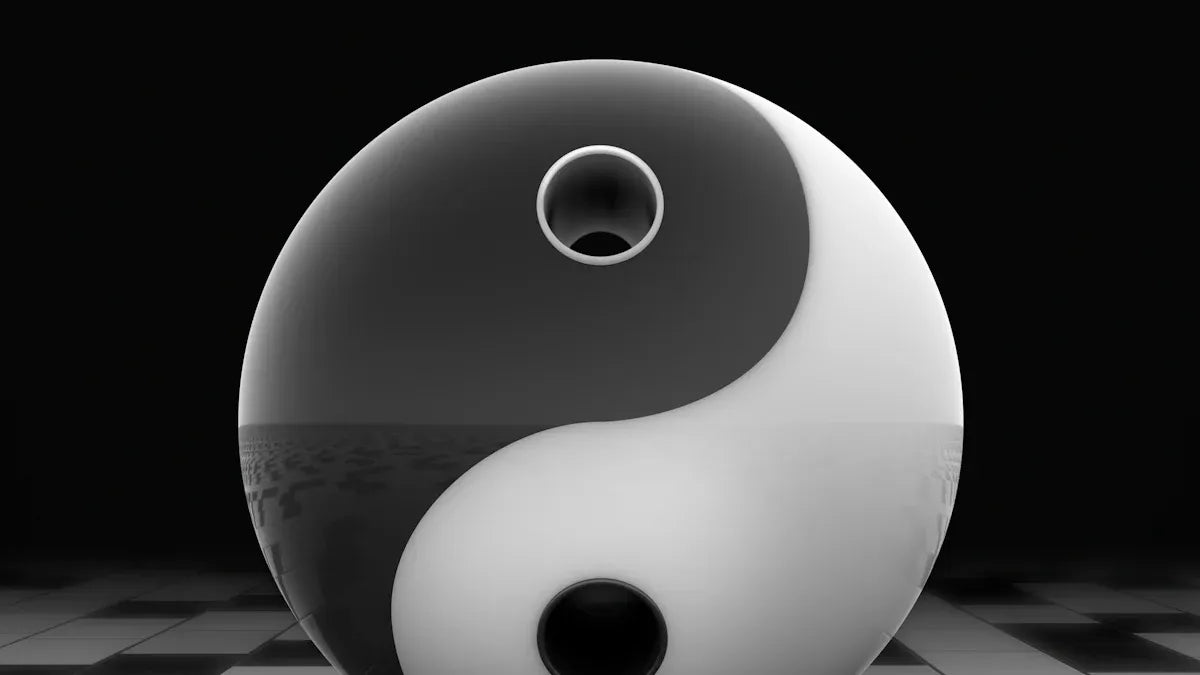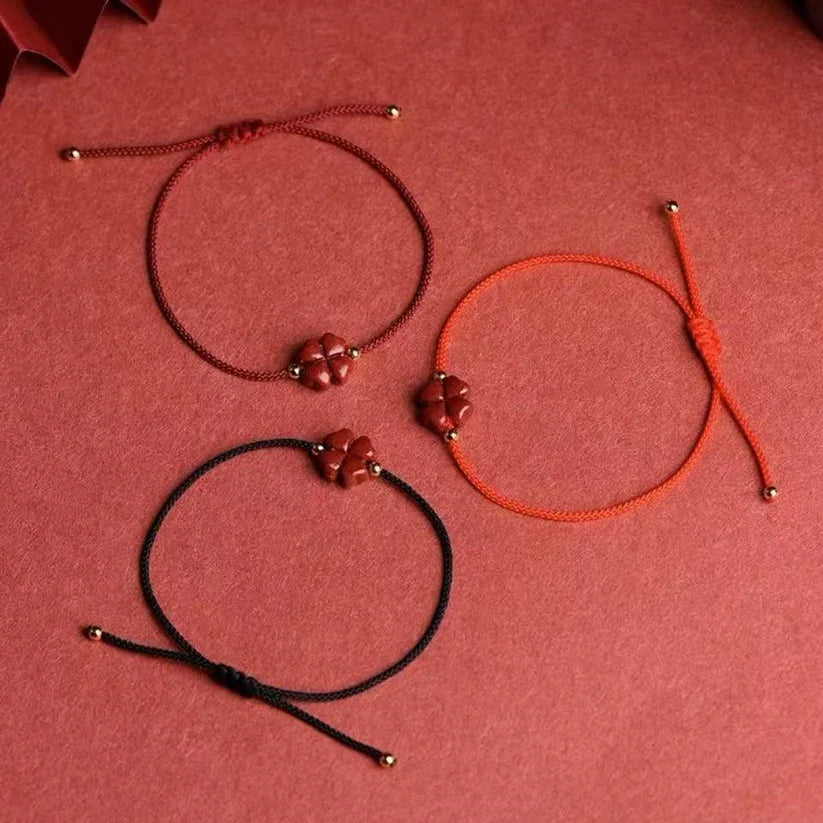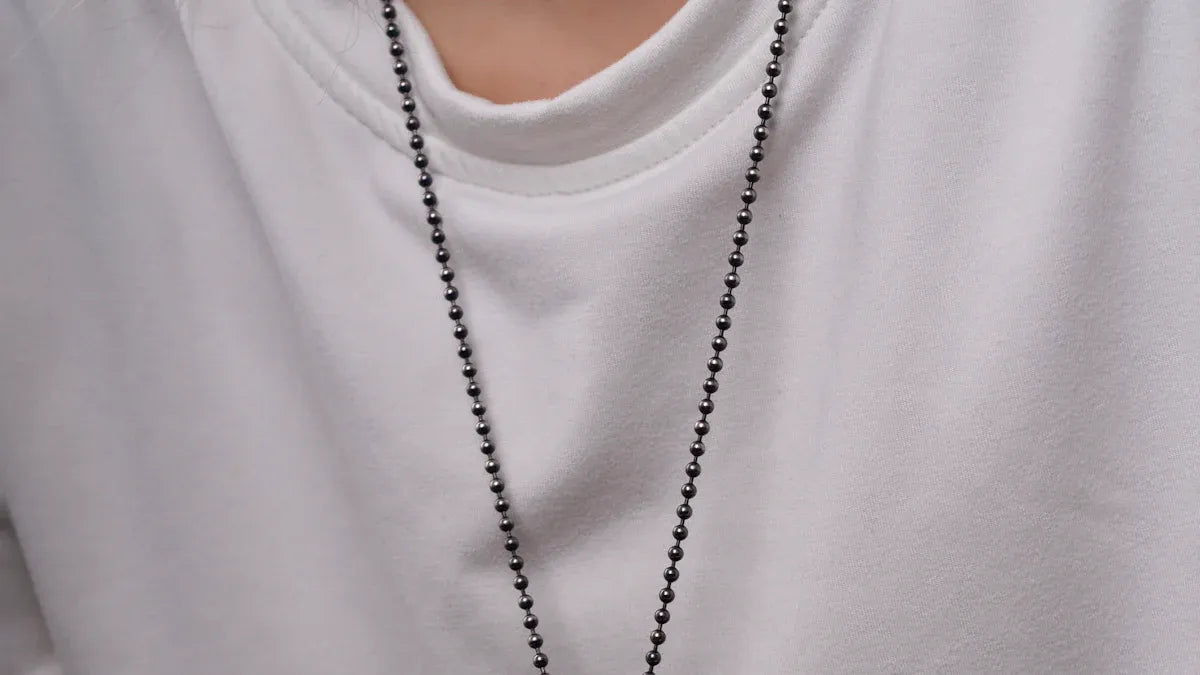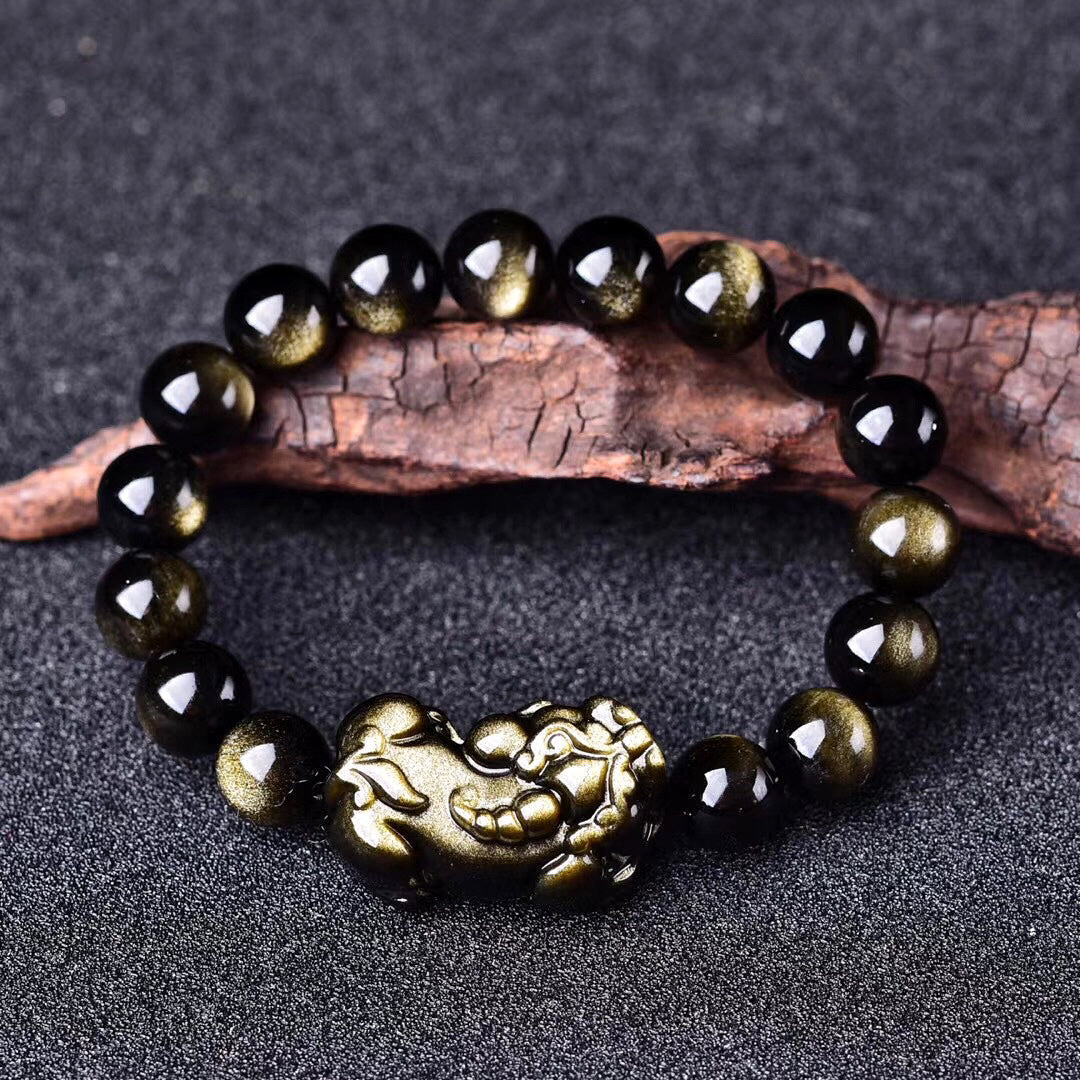Yin and yang are two opposite forces that are linked. They shape everything in the world. People think yin and yang show balance. Each force needs the other to exist. Learning about yin and yang helps people see push and pull in nature, health, and relationships. This idea says that balance brings harmony in life.
Key Takeaways
Yin and yang are two opposite forces. They work together to make balance and peace in life. The yin-yang symbol shows each side has a little of the other. This means nothing is only one or the other. Yin stands for coolness, rest, and quiet strength. Yang stands for warmth, action, and energy. Balance between yin and yang keeps nature, health, and relationships steady and calm. Yin and yang always change and turn into each other. This shows that change is normal and needed. Traditional Chinese Medicine uses yin and yang to understand health. It also helps guide ways to heal. People use yin and yang ideas in daily life. They mix rest with activity and listening with speaking. The old roots and Taoist philosophy of yin and yang teach us to respect both sides. They show us how to live in peace with change.
Yin and Yang
Core Meaning
Yin and yang are two forces in Chinese philosophy. They seem different, but they work together. Many experts say yin and yang show that everything has a pair. For example, there is light and dark, hot and cold, or moving and still. Each force needs the other to be complete. This idea is in books like the Tao Te Ching and the I Ching. These books teach that balance brings harmony. The yinyang idea helps people see the world as a place of balance and change.
The yinyang theory says all things have both yin and yang. This balance brings harmony to life and nature.
Duality
Yin and yang show that two different things can make a whole. In Chinese beliefs, yin means darkness, coolness, and rest. Yang means brightness, warmth, and activity. These qualities do not fight each other. They work together to keep things balanced. The yinyang symbol is a circle with black and white halves. Each half has a dot of the other color. This shows that each side has a bit of the other.
Yin and yang are not just opposites. They work together to make balance.
The world moves in cycles, like day and night or the seasons. These cycles show the dual nature of yinyang.
The I Ching uses patterns called hexagrams to show how yin and yang change.
Old books and new experts agree that yinyang means unity in duality. The two sides always connect, so nothing stands alone.
Interconnectedness
Yinyang also teaches that everything is connected. Yin and yang cannot exist alone. When one gets bigger, the other gets smaller, but both stay. For example, after a busy day (yang), people need rest (yin). In nature, summer (yang) leads to winter (yin), and the cycle goes on. The yinyang idea helps people see that change is normal and needed for balance.
The yinyang symbol reminds us that every action has a reaction. Every part of life connects to another, making a web of balance.
Philosophers use yinyang to explain health, feelings, and choices. They think finding balance between yin and yang makes life better. The yinyang idea shapes Chinese medicine, martial arts, and daily life. It shows that harmony comes from respecting both sides of every situation.
Yinyang Symbol
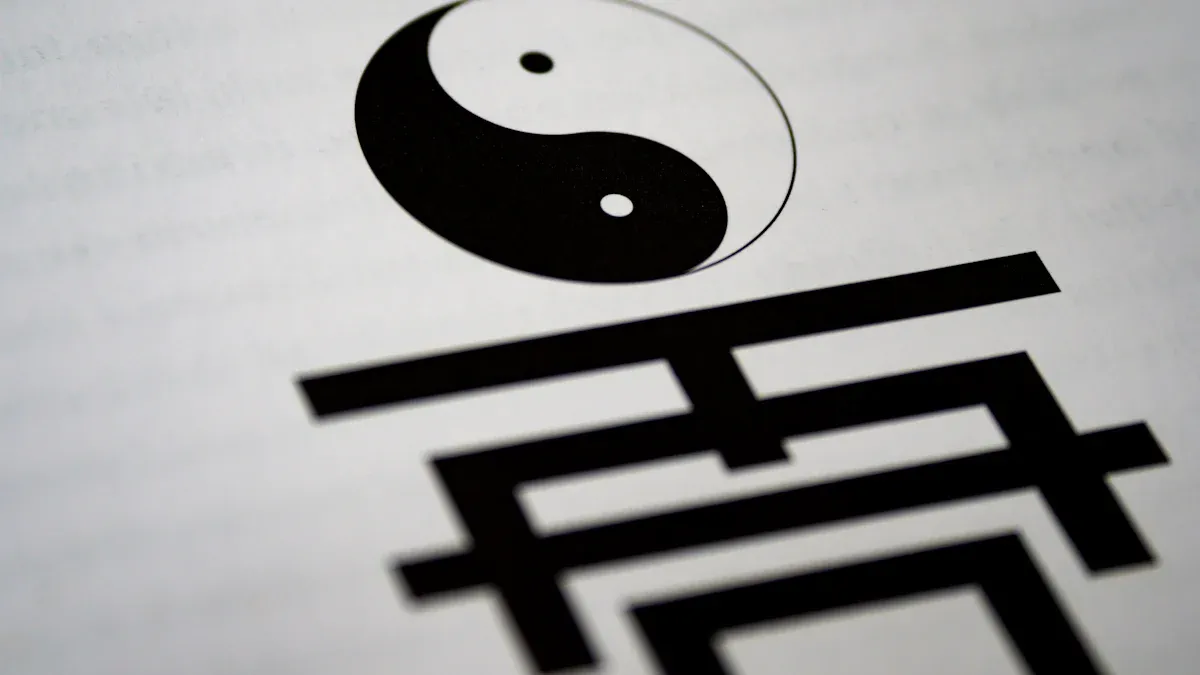
Visual Elements
The yinyang symbol is easy to spot because of its bold look. It is a circle split by a curvy S-shaped line. This line makes two shapes that look like teardrops. One side is black, and the other is white. The black side stands for yin. The white side stands for yang. Each side has a small dot of the other color. The circle means everything is whole and never ends. The S-curve shows how yin and yang move together. The symbol uses black and white to show how dark and light, or rest and action, work as a team.
The circle means unity and the universe.
The S-curve means things always change and stay balanced.
The dots mean each side has a little of the other.
The yinyang symbol helps people remember that nothing is just one thing. Every force has a bit of its opposite inside.
Taijitu
The most well-known yinyang symbol is called the Taijitu. This design has been important in Chinese culture for a long time. The Taijitu first showed up in the 11th century AD. But the ideas behind it are much older. Zhou Dunyi, a famous thinker, said Taiji means "Supreme Polarity." This means yin and yang come from one place and make everything in the world. The Taijitu shows this by mixing both halves in a perfect circle.
Aspect |
Description |
|---|---|
Earliest Chinese Yin-Yang Representations |
Started in the 11th century AD, but people talked about yin-yang since the 4th or 5th century BC |
Philosophical Foundation |
Zhou Dunyi (1017–1073), a Song Dynasty thinker, wrote Taijitu shuo, mixing Taoist, Buddhist, and Confucian ideas; he said Taiji is Supreme Polarity that makes yin and yang |
Key Philosophical Concepts |
Taiji is the way yin and yang move and take turns, making the Five Phases and the order of the world; Taiji is not a thing but a rule of opposites |
Modern Definition Support |
The old pictures and Zhou Dunyi’s ideas help people today see Taijitu as a sign of cosmic duality and harmony between opposites |
The Taijitu helps people see that yin and yang are always moving and changing. They are never stuck. The yinyang symbol is found in art, rugs, and even logos. This shows it is still important today.
Symbolic Balance
The yinyang symbol shows balance in a simple way. The black and white sides swirl together. Each side has a dot of the other color. This means yin and yang are not just opposites. They need each other. In nature, day becomes night, and light turns into shadow. The yinyang symbol shows this cycle. Old stories, like the tale of Pangu, use yin and yang to explain how earth and sky began. The throne of the goddess Xi Wang Mu has a dragon and tiger to show balance, just like the yinyang symbol.
The swirling sides show harmony and why both are needed.
The dots mean each force has a bit of the other.
The circle shape means change never ends.
Designers use the yinyang symbol to show balance in many ways. They might use new colors or patterns, but the main idea stays the same. The symbol teaches that real harmony comes from respecting both sides in every situation.
The yinyang symbol is more than just a picture. It teaches about balance, change, and how everything is connected.
Meaning Behind Yin and Yang
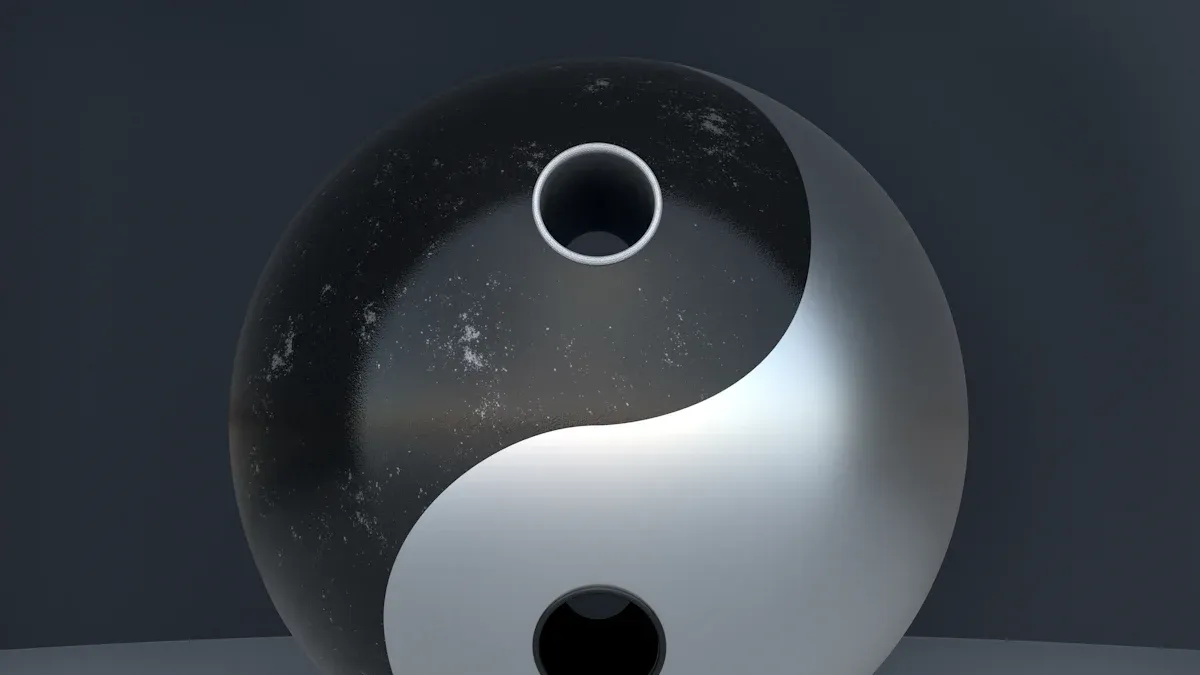
Opposites
The meaning of yin and yang starts with opposites. Yinyang shows that everything in nature has two sides. These sides are not fighting each other. They need each other to exist. For example, day needs night, and hot needs cold. Rest and activity also show this idea. Each side is there because the other side is too.
Yinyang work together and depend on each other.
Their differences help keep nature balanced.
Each force can change into the other.
Scientists found this balance is real, not just an idea. In the body, the immune system and gut bacteria work like yinyang. If one gets too strong, problems can start. This idea is used in Chinese medicine. Doctors check for too much yin or too much yang to find sickness. The meaning of yin and yang helps people see that opposites keep life healthy and balanced.
Yinyang teaches that every force in nature has an opposite, and both are needed for balance.
Harmony
Yinyang is not just about opposites. It also means harmony. The meaning of yin and yang shows that balance comes from working together. When yin and yang join, they make peace in nature, health, and relationships.
Studies show people in China use yinyang thinking to solve problems. They try to mix differences instead of fighting. This helps families, friends, and workers get along. Researchers made models to show how yinyang explains harmony and conflict. These models show yinyang is a good way to understand how people work together.
Harmony comes from balancing opposites.
Yinyang thinking helps people solve problems and build strong bonds.
The Five Elements model uses yinyang to show how things stay steady and change.
The yinyang idea reminds people that true harmony means respecting both sides and finding a middle path.
Transformation
The meaning of yin and yang also includes change. Yinyang is not stuck. Each side can turn into the other. For example, day becomes night, and winter turns into spring. This cycle keeps going. Change is a big part of yinyang.
Scientists and thinkers use yinyang to explain how things grow and change. In medicine, experts use yin and yang scores to study health. In business, leaders use yinyang thinking to balance new ideas and careful plans. Studies show yinyang helps people see how change happens in groups.
Transformation in yinyang is like a dance. Each side takes turns leading. This keeps life new and balanced. Philosophers say yinyang is a model for how energy and information move. This model helps people see that change is normal and important.
Aspect |
Yin Example |
Yang Example |
Transformation Example |
|---|---|---|---|
Nature |
Night |
Day |
Sunrise and sunset |
Health |
Rest |
Activity |
Sleep-wake cycle |
Relationships |
Listening |
Speaking |
Conversation flow |
Seasons |
Winter |
Summer |
Spring and autumn |
Yinyang teaches that change is always happening. Transformation keeps the world in balance.
Yin Explained

Characteristics
Yin stands for many qualities in Chinese philosophy. People often describe yin as cool, dark, and quiet. It connects to the earth, water, and the moon. Yin shows patience, softness, and the ability to absorb. In nature, yin appears in valleys, streams, and shaded places. Ancient texts say yin represents femaleness and passivity. The tiger often symbolizes yin, showing its quiet strength. In the I Ching, yin appears as broken lines in hexagrams, which means it is flexible and open.
Researchers have found that yin qualities also show up in the brain. People with more yin traits have stronger connections in areas linked to emotions. This means yin can relate to emotional depth and richness. In daily life, yin helps balance the active, outward push of yang. Without yin, there would be no rest or recovery. Yin and yang energy work together to keep life in balance.
Yin is not weak. It is the power of stillness, reflection, and gentle strength.
Symbolism
Yin carries deep meaning in art, stories, and culture. Many symbols show yin’s qualities:
The color black stands for yin, showing quiet and hidden energy.
Ancient Chinese writing used yin to track shadows and the sun’s path.
By 600 BC, people saw yin as a symbol of balance, not just darkness.
The yin-yang symbol uses a curved line and dots to show how yin and yang flow into each other.
Yin stands for quietness, rest, and the unseen side of things.
Cultural studies show that yin also means cold and femininity. In many Asian cultures, mothers follow special rituals after childbirth to restore yin. These traditions, passed down by elders, help bring back balance after the body loses blood. The I Ching and other old books support these ideas, showing yin as a key part of harmony in the universe.
The yin side of the yin-yang symbol reminds people that every bright moment has a shadow, and every action needs a time of rest.
Yin in Life
Yin shapes many parts of daily living. In Traditional Chinese Medicine, yin means coolness, lightness, and the body’s ability to rest and heal. Doctors look for signs of yin balance to judge health. When someone has too little yin, called Yin-Xu, they may feel tired, anxious, or have trouble sleeping. Studies show that people with Yin-Xu, especially those with chronic illnesses like diabetes, often have lower quality of life. They may struggle with both physical and mental health.
Yin also guides how people make choices. It teaches patience, careful watching, and waiting for the right time to act. In relationships, yin helps people listen and support others. In nature, yin appears in winter, night, and the quiet growth of seeds underground. When yin falls out of balance, life can feel rushed or empty.
A healthy life needs both action and rest. Yin gives the calm and space needed for growth and healing.
Yang Explained

Characteristics
Yang stands for energy that moves outward. It shows up as brightness, heat, and activity. In Chinese philosophy, yang links to the sun, daylight, and the start of new things. Yang often represents the male side, but its original meaning comes from the sunny side of a mountain. This shows that yang is not just about gender. It is about function and context.
Yang brings qualities like:
Light and warmth
Action and movement
Strength and clarity
Growth and expansion
Classical texts, such as the Daoist Taipingjing and the writings of Dong Zhongshu, connect yang with the male principle. However, scholars explain that yang’s true meaning is relational. It works as a category that changes based on what it pairs with. The Internet Encyclopedia of Philosophy notes that yang acts as a functional force, not a fixed thing. Yang always relates to yin, and together they create balance.
Yang energy drives change and brings things to life. It stands for the active, visible side of nature.
Yang also links to the start of the day, springtime, and the upward movement of plants. In the body, yang shows up as warmth, energy, and the power to act. Without yang, nothing would grow or move forward.
Symbolism
Yang carries deep meaning in art, stories, and daily life. Ancient Chinese texts use yang to symbolize the axis, or the center of awareness. Yang stands for focus, memory, and the ability to stay alert. In the Analects and the Book of Changes, yang appears as the force that keeps order and helps people remember what matters.
Yang is outward, bright, and hot.
It links to the sun, fire, and the color white or yellow.
Artists use yang to show action, light, and the start of new cycles.
In the Five Elements theory, yang connects with wood and fire, which both grow and spread.
Researchers studying Chinese art found that yang often appears in symbols of power and leadership. For example, emperors wore yellow robes to show their central role in keeping harmony. Yang’s active side shows up in dragons, which stand for strength and good luck.
Yang symbols help people see the value of action, focus, and leadership in their culture.
Yang’s meaning also appears in how people use space and color. Bright, open spaces and warm colors in buildings or paintings show yang energy. These choices reflect the belief that yang brings life and order.
Yang in Life
Yang shapes many parts of daily living. In health, yang stands for the body’s warmth, energy, and drive. Traditional Chinese Medicine (TCM) uses yang to explain how the body fights illness and stays active. Doctors look for signs of yang balance, such as strong pulse, clear thinking, and good energy. When yang drops too low, people may feel cold, weak, or tired. Too much yang can cause restlessness or overheating.
Yang also guides how people act and make choices. It teaches the value of taking action, speaking up, and leading others. In relationships, yang helps people express ideas and solve problems. In nature, yang appears in summer, daytime, and the burst of growth in spring.
Aspect |
Yang Example |
How Yang Shows Up in Life |
|---|---|---|
Nature |
Sunlight |
Plants grow toward the sun |
Health |
Body warmth |
Energy for work and play |
Relationships |
Speaking |
Sharing ideas and leading groups |
Seasons |
Summer |
Outdoor activities and celebrations |
Yang also shapes culture and art. Artists use yang symbols to show movement and power. Leaders use yang ideas to inspire action and build strong teams. In daily routines, people start the day with active tasks to match the rising yang energy.
A balanced life needs both rest and action. Yang gives the spark that moves people forward and helps them reach their goals.
Origins
Ancient Roots
The idea of yin and yang began long ago in ancient China. Early artifacts and writings show how people started to think about these two forces. Archaeologists found oracle bones from the Shang Dynasty, dating back to the 14th century BC. These bones have symbols that relate to yin and yang, used for telling the future. The Shijing (Book of Songs), written between the 11th and 7th centuries BC, describes yin as the shady side and yang as the sunny side of a hill. This shows that people noticed patterns in nature and gave them names.
Philosophers during the Zhou and Han Dynasties, such as Confucius and Lao Tzu, helped shape the meaning of yin and yang. They wrote about how these forces work together in life and the world. The first Chinese dictionary, made around 100 AD, explains yin and yang by using examples from nature and directions. The Tao Te Ching, a famous book by Lao Tzu, describes yin and yang as the main forces that create harmony.
Oracle bones from the Shang Dynasty show early yin-yang symbols.
The Shijing gives the first written ideas about yin and yang.
Ancient thinkers like Confucius and Lao Tzu explained how yin and yang work.
The oldest Chinese dictionary links yin and yang to nature.
A clay disk from Ukraine, about 7,000 years old, has a black and white pattern like the yin-yang symbol. While this disk is older than Chinese records, experts do not know if it connects to the Chinese idea. It may be a coincidence or a sign that people in different places noticed similar patterns.
Taoism
Taoism plays a key role in the story of yin and yang. This philosophy teaches that yin and yang are not just opposites but are connected and always changing. Taoism says that the Tao, or the Way, is the force behind everything. The Tao Te Ching and the Zhuangzi, two important Taoist books, talk about living in harmony with the Tao. They show that yin and yang are always moving and depend on each other.
Taoism introduces the idea of wu wei, which means acting without force. This helps keep yin and yang in balance. Yin stands for darkness, rest, and softness. Yang stands for light, action, and strength. Taoism teaches that both are needed for peace and health. The yin-yang symbol shows this balance and the way these forces flow together. Taoism’s ideas shape not only philosophy but also medicine, feng shui, and martial arts.
Taoism teaches that harmony comes from respecting both yin and yang, letting them change and support each other.
Cultural Impact
Yin and yang have shaped Chinese culture and thinking for thousands of years. People use these ideas to explain health, nature, and even how to solve problems. Traditional Chinese medicine uses yin and yang to find balance in the body. Doctors look for signs of too much or too little yin or yang to help people feel better.
Artists use the yin-yang symbol in paintings, clothes, and buildings. The symbol reminds people to look for balance in life. Martial arts, like tai chi, use yin and yang to teach movement and stillness. Even today, people around the world use yin and yang to talk about balance, change, and harmony.
Yin and yang guide health, art, and daily choices.
The symbol appears in many parts of life, from medicine to design.
These ideas help people understand the world as a place of balance.
Modern Relevance
Daily Life
Yin and yang ideas still affect how people live now. Many people in East Asia try to keep balance in their lives. A big survey found that people in these places care a lot about harmony. They think being happy means having peace at home, work, and in the community. People believe both rest and activity matter. For example, students mix study time with play. Workers take breaks to balance hard work.
People who use yin and yang thinking want steady lives. They do not only care about winning or losing. They try to find a middle way.
In cities today, families use yin and yang to make choices. They might eat both warm and cool foods at meals. They may make homes with bright and quiet spots. These habits help people feel calm and pay attention.
Health
Yin and yang ideas are still important in Traditional Chinese Medicine. Doctors use them to understand health and sickness. They think health comes from balance inside and outside the body. New studies show TCM uses yin and yang to check health in new ways. For example, Chinese health tests use these ideas to see if someone feels balanced.
A long study with over 2,400 people showed how yin and yang affect the body. The study helped doctors find better ways to treat sickness by watching how energy moves. TCM doctors use yin and yang to guide care. They may suggest herbs, foods, or exercises to bring back balance. Western medicine sometimes works with TCM now. Many hospitals use both to help people get better.
Health experts say keeping yin and yang balanced can stop sickness and help people heal.
Relationships
Yin and yang ideas also help people get along with others. In families, with friends, and at work, people use these ideas to solve problems and build trust. They know everyone has quiet and active sides. Good relationships need both listening and talking, giving and taking.
A table shows how yin and yang work in relationships:
Yin (Quiet, Support) |
Yang (Active, Lead) |
|---|---|
Listening |
Speaking |
Comforting |
Encouraging |
Waiting |
Acting |
People who use yin and yang thinking try not to fight. They look for ways to mix differences. This helps groups stay strong and happy. In many cultures, leaders use these ideas to guide teams and families. They know balance brings peace.
Harmony in relationships grows when people respect both sides and work together.
Yin and yang teach that life needs balance and connection. These two forces help each other in nature, health, and friendships. Old books and symbols, like the Taijitu, show why they matter.
Yin and yang are different but need each other to work.
They switch and change, which keeps things peaceful.
This idea helps people handle changes and feel calm.
People can use yin and yang ideas to make life more balanced and flexible every day.
FAQ
What does yin and yang mean?
Yin and yang describe two opposite forces that work together. Yin stands for darkness and rest. Yang stands for light and activity. Together, they show how balance creates harmony in life.
Why does the yin-yang symbol have dots?
The dots show that each side contains a small part of the other. This means nothing is completely yin or completely yang. Change and balance always exist.
Can yin and yang change into each other?
Yes. Yin can become yang, and yang can become yin. For example, night turns into day. This cycle helps keep nature and life balanced.
How do people use yin and yang in daily life?
People use yin and yang to find balance. They mix rest with activity, eat different foods, and solve problems by looking for harmony. Many use these ideas in health, work, and relationships.
Is yin always bad and yang always good?
No. Yin and yang do not mean good or bad. Both are important. Each one helps the other. Balance between them brings health and peace.
Where can someone see yin and yang in nature?
Nature shows yin and yang in many ways. Day and night, summer and winter, and even the flow of rivers and mountains all show this balance.
Tip: Look for pairs in your daily life. You may notice yin and yang everywhere!

